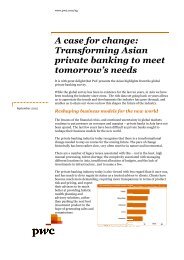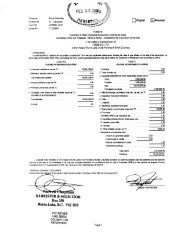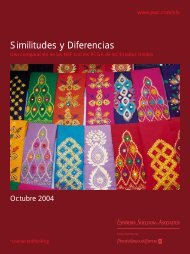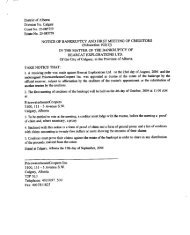TLS Newsletter 11 marzo 2011 - PwC
TLS Newsletter 11 marzo 2011 - PwC
TLS Newsletter 11 marzo 2011 - PwC
Create successful ePaper yourself
Turn your PDF publications into a flip-book with our unique Google optimized e-Paper software.
Milleproroghe e le imposte anticipate<br />
nel bilancio delle banche e<br />
degli enti finanziari<br />
(Alessandro Catona)<br />
Il cosiddetto decreto “Milleproroghe” (D.L. n. 225/2010<br />
convertito con la Legge n. 10/20<strong>11</strong>) ha introdotto alcune<br />
novità di carattere fiscale per le banche e gli enti finanziari.<br />
In particolare, il comma 55 e seguenti, articolo 2,<br />
prevedono che, nel caso in cui nel bilancio individuale<br />
emerga una perdita d’esercizio, le attività per imposte<br />
anticipate iscritte in bilancio, relative a svalutazioni di<br />
crediti non ancora dedotte dal reddito imponibile ai sensi<br />
del comma 3, articolo 106, TUIR, e quelle relative al<br />
valore dell’avviamento e delle altre attività immateriali,<br />
i cui componenti negativi sono deducibili in più periodi<br />
d’imposta ai fini delle imposte sui redditi, si trasformino<br />
in crediti d’imposta.<br />
La conversione decorre dalla data di approvazione del<br />
bilancio da parte dell’assemblea dei soci ed opera per<br />
un importo pari al prodotto tra la perdita d’esercizio e<br />
il rapporto tra le attività per imposte anticipate di cui al<br />
comma 55 e la somma del capitale sociale e delle riserve<br />
(sulla base dei dati emergenti dal bilancio approvato).<br />
“Perdita d’esercizio x[ Attività per imposte anticipate<br />
comma 55 /(Capitale Sociale + Riserve)] = Attività<br />
fiscali (comma 55) soggette a trasformazione” .<br />
Il credito così calcolato deve trovare indicazione nella<br />
dichiarazione dei redditi e non concorre alla formazione<br />
del reddito né ai fini Ires o Irap. La norma ha, infine,<br />
stabilito che il credito può essere ceduto o utilizzato in<br />
compensazione, ma mai chiesto a rimborso e non è produttivo<br />
di interessi.<br />
Dal periodo di imposta in corso alla data di approvazione<br />
del bilancio, non sono deducibili i componenti negativi<br />
corrispondenti alle attività per imposte anticipate trasformate<br />
in credito di imposta.<br />
L’ambito soggettivo della norma sembra estendersi, per<br />
quanto riguarda le imposte anticipate su svalutazione<br />
crediti, ai soggetti di cui all’articolo 1, D.Lgs. n. 87/92, in<br />
quanto richiamato dall’articolo 106, comma 3, TUIR.<br />
Con riferimento, invece, alle imposte anticipate su<br />
avviamenti e altre attività immateriali, pur richiamando<br />
la norma il nuovo accordo di Basilea rilevante per<br />
le banche e gli enti finanziari, la nuova disposizione<br />
sembrerebbe letteralmente applicabile anche ad altri<br />
soggetti IRES (sebbene il punto meriterebbe comunque<br />
un chiarimento).<br />
The “Milleproroghe” Bill:<br />
conversion of deferred tax assets<br />
for banks and financial companies<br />
(Alessandro Catona)<br />
The Law Decree 225/2010 (so-called “Milleproroghe”, converted<br />
into Law No. 10/20<strong>11</strong>) introduced some new provisions<br />
regarding banks and financial institutions taxation.<br />
In particular, paragraph 55 and following of Article 2<br />
provides that, where a loss arises in the individual financial<br />
statements, the deferred tax assets recorded, related to<br />
write-downs of receivables not yet deducted from taxable<br />
income pursuant to paragraph 3, Article 106, Income Tax<br />
Code, and those related to goodwill and other intangible<br />
assets, the negative components of which are deductible in<br />
several periods, will turn into tax credits.<br />
The conversion starts from the date of approval of the balance<br />
statement by the shareholders’ meeting and operates<br />
in an amount equal to the product of the loss for the year<br />
and the ratio of deferred tax assets as per paragraph 55<br />
and the sum of the share capital and reserves (based on<br />
data emerging from the approved balance sheet).<br />
Tax loss×[Deferred tax assets paragraph 55/(Share<br />
Capital+Reserves )]=Tax assets (paragraph 55) to be<br />
converted.<br />
The credit so computed shall be indicated in the income<br />
tax return and shall not be included in the taxable base<br />
for IRES and IRAP purposes. The provision states that the<br />
credit can be transferred or used in compensation for other<br />
taxes payment, but never asked for refund and is not interest<br />
productive.<br />
From the tax period in progress at the date of approval<br />
of the budget, negative components corresponding to the<br />
deferred tax assets converted into tax credits are no longer<br />
deductible for tax purposes.<br />
The provision shall be applicable, with respect to deferred<br />
tax assets on bad debts, to companies included in Article<br />
1, Legislative Decree no. 87/92, as reported in Article 106,<br />
paragraph 3, Income Tax Code.<br />
With reference to the deferred tax assets on goodwill and<br />
other intangible assets, although reference is made to the<br />
new Basel Accord for banks, the new provision would seem<br />
literally applicable also to other entities subject to IRES (the<br />
point, however, has to be clarified).<br />
49 <strong>TLS</strong> <strong>Newsletter</strong> n° 3 Anno 20<strong>11</strong>
















